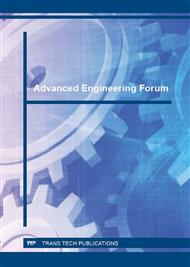[1]
Straub, D & Faber, MH. Computational aspects of risk-based inspection planning. Computer-aided Civil and Infrastructure Engineering, 2006, 21 (3): 179-92.
DOI: 10.1111/j.1467-8667.2006.00426.x
Google Scholar
[2]
Zou YJ. The Role of Structural Health Monitoring in Bridge Assessment and Management. Thesis (PhD). Lehigh University, Bethlehem, PA, USA, (2011).
Google Scholar
[3]
Li H, Zhou WS, Ou JP, et. al. A study on system integration technique of intelligent monitoring systems for soundness of long-span bridges. China Civil Engineering Journal, 2006, 39(2): 46-52. (in Chinese).
Google Scholar
[4]
Li AQ, Miu CQ, Li ZX, et. al. Health monitoring system for the Runyang Yangtse River Bridge. Journal of Southeast University, 2003, 33(5): 544-548. (in Chinese).
Google Scholar
[5]
Qin Q. Health monitoring of long-span bridges. China Journal of Highway and Transport, 2000, 13(2): 37-42(in Chinese).
Google Scholar
[6]
Chana THT, Yua L &Tam HY. Fiber Bragg Grating Sensors for Structural Health Monitoring of Tsing Ma Bridge: Background and Experimental Observation. Engineering Structures, 2006, 28: 648-659.
DOI: 10.1016/j.engstruct.2005.09.018
Google Scholar
[7]
Hu XY, Wang B & Ji H. A Wireless Sensor Network-based Structural Health Monitoring System for Highway Bridges. Computer-Aided Civil and Infrastructure Engineering, 2013, 28(3): 193-209.
DOI: 10.1111/j.1467-8667.2012.00781.x
Google Scholar
[8]
Liu M, Frangopol DM, Kim S. Bridge safety evaluation based on monitored live load effects. Journal of Bridge Engineering, 2009, 14(4): 257-269.
DOI: 10.1061/(asce)1084-0702(2009)14:4(257)
Google Scholar
[9]
Wang Y, Jing GG, Wang B. On-line Structural Analysis and State Evaluation Method for Bridge Health Monitoring System. Bridge Construction, 2014, 44(1): 25-30.
Google Scholar
[10]
Ching J, Muto M & Beck JL, (2006). Structural Model Updating and Health Monitoring with Incomplete Modal Data Using Gibbs Sampler. Computer-Aided Civil and Infrastructure Engineering, 2006, 21(4): 242–257.
DOI: 10.1111/j.1467-8667.2006.00432.x
Google Scholar
[11]
Xiang J & Liang M. Wavelet-based Detection of Beam Cracks Using Modal Shape and Frequency Measurements. Computer-Aided Civil and Infrastructure Engineering, 2012, 27(6): 439-454.
DOI: 10.1111/j.1467-8667.2012.00760.x
Google Scholar
[12]
Yuen KV & Katafygiotis LS. Substructure Identification and Health Monitoring Using Response Measurement Only. Computer-Aided Civil and Infrastructure Engineering, 2006, 21(4): 280-291.
DOI: 10.1111/j.1467-8667.2006.00435.x
Google Scholar
[13]
Fan XP & Lu DG. Real-time reliability forecast of bridge structures based on multiple Bayesian dynamic linear models. Journal of South China University of Technology, 2013, 41(3): 67-72. (in Chinese).
Google Scholar
[14]
Fan XP & Lu DG. Reliability prediction of aging bridges based on Bayesian dynamic linear model. Journal of the china railway society, 2014a, 36(6), 93-98.
Google Scholar
[15]
Fan XP & Lu DG. Reliability prediction of bridges based on monitored data and Bayesian dynamic models. Key Engineering Materials, 2014b, 574, 77-84.
DOI: 10.4028/www.scientific.net/kem.574.77
Google Scholar
[16]
Fan XP & Lu DG. Reliability prediction of bridge structures based on BDNM. Journal of Harbin Institute of Technology, 2014c, 46(2), 1-5.
Google Scholar
[17]
Zhao Z, (2012). Health Monitoring Data Modeling and Reliability Analysis for Yitong River Bridge based on ARMA Model. Thesis(Master's degree), Harbin Institute of Technology, Harbin, China, 2012. (in Chinese).
Google Scholar
[18]
Peng YH, Liu YF, Miu D & Yang XG. Application of Gaussian Mixture Particle Filter on State Estimation. DANJIAN YU ZHIDAO XUEBAO, 2007, 27(1): 271-274.
Google Scholar
[19]
Tang HY. Key Technology of Structural Design and Construction Control of Tianjin Fumin Bridge. Thesis (Master's degree), Tianjin University, Tianjin, China, 2010. (in Chinese).
DOI: 10.29268/stsc.2015.3.4.3
Google Scholar
[20]
Chen SF & Yang DW. Health Monitoring System Project of Tianjin Fumin Bridge. School of Transportation Science and Engineering, Harbin Institute of Technology, Harbin, China, 2010. (in Chinese).
Google Scholar


